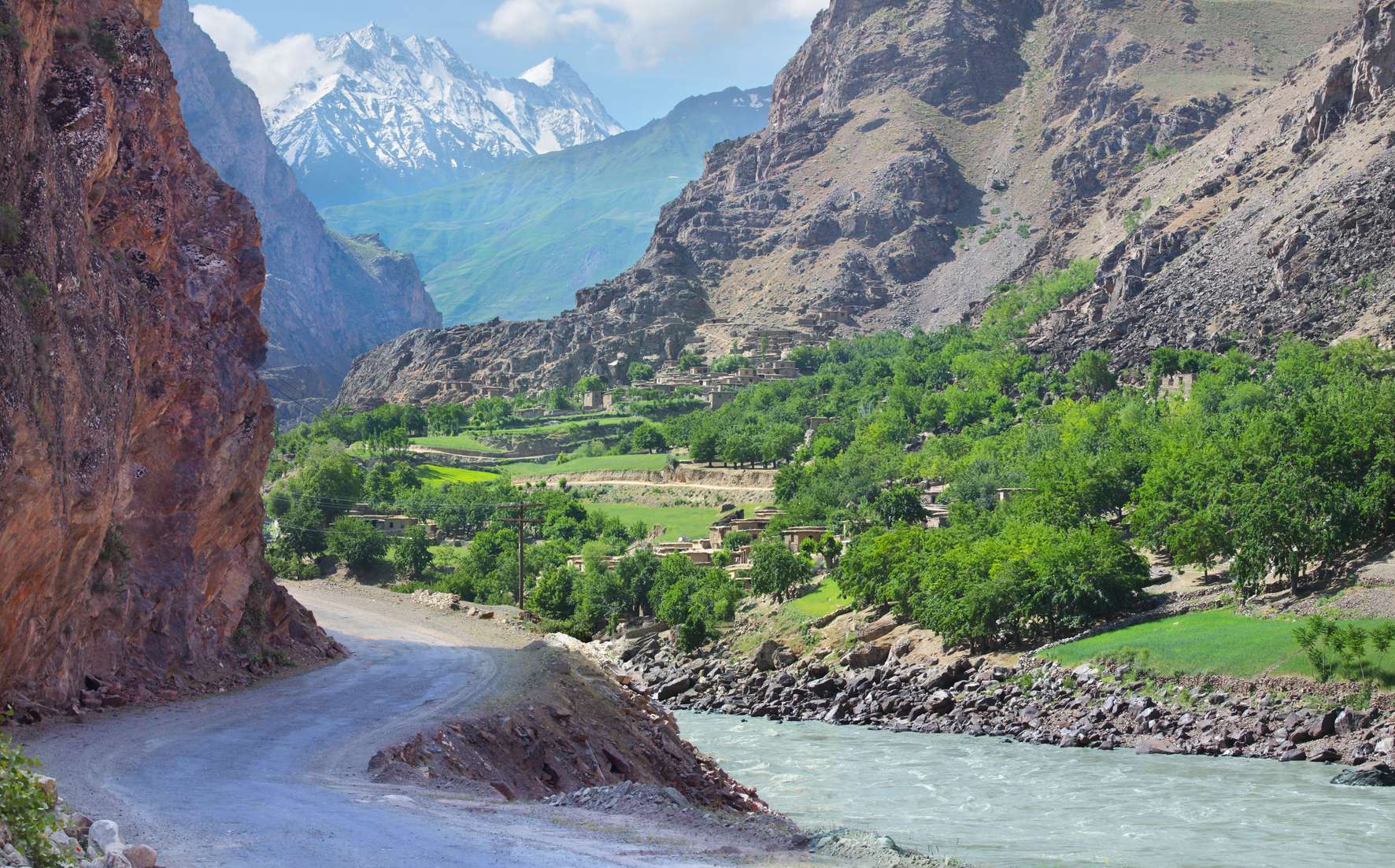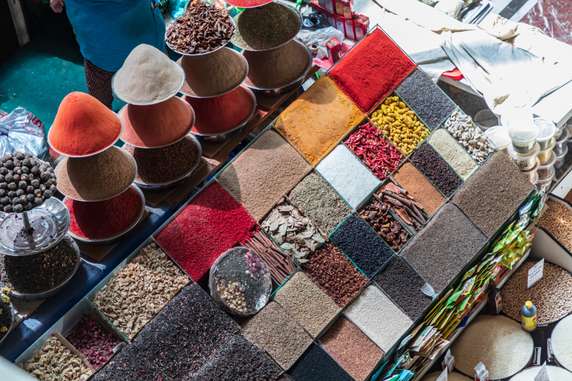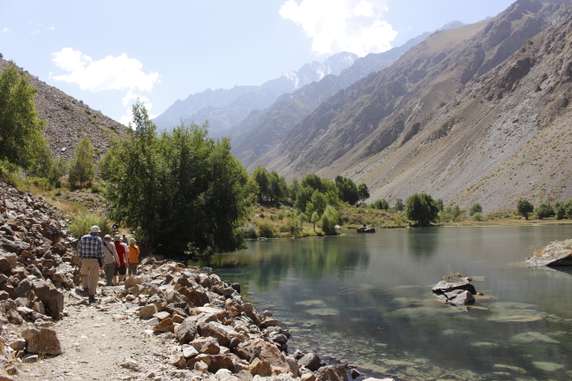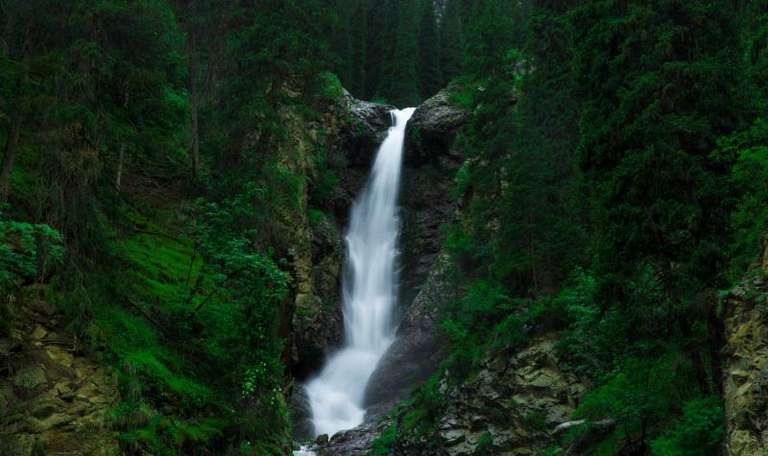Highlights
Drive along the spectacular Pamir Highway
Enjoy views to the Hindu Kush and Karakorum mountains
Peer across the Panj river into Afghanistan
Trace the lines of the Wakhan Corridor, a region associated with the Great Game
Visit archaeological sites and remnants of the Silk Road
Search for Marco Polo sheep and markhor goats
Take a day walk between remote villages in Bartang
Search for Marco Polo sheep and markhor goats
Take a day walk between remote villages in Bartang
Itinerary
For those drawn to the world’s most remote frontiers, the "Tajikistan Expedition: Pamir Highway & beyond" tour is a rare gateway to Central Asia’s hidden marvels. Spanning 16 days from Dushanbe in a small group, this cultural and historic tour is especially suited to seniors seeking a moderate yet adventurous pace. Journey in 4x4s along the legendary Pamir Highway, hugging the Afghan border and the wild Panj River, exploring lands where languages and traditions shift from valley to valley. Marvel at ancient Zoroastrian castles, Buddhist stupas, and the ever-changing landscapes of the towering Pamir range. The itinerary’s unique selling point is its figure-eight route, minimizing backtracking and maximizing discovery—you’ll see more, retracing your steps only rarely, for a fuller immersion into Tajikistan’s enigmatic beauty.
day 1 - Arrive Dushanbe
Arrive into Dushanbe today (or very early morning next day) and overnight.
day 2 - Explore Dushanbe
We leave the hotel around 10.30am and start exploring Dushanbe, the capital of Tajikistan. We start with an overview of Tajik history at the National Museum of Antiquities, where we see a reclining Buddha statue. Next, we visit Mehrgon Market where we can try local fruits and learn Tajik bargaining skills.
We have lunch (not included) in a cafe within a training centre run by the NGO Chatr, which means umbrella. The centre provides free courses to women who have suffered abuse.
Later in the afternoon, we walk beside the fountains of Rudaki Avenue and visit the Rudaki Monument, dedicated to the founder of Tajik-Persian literature. We also see the Ismail Somoni monument to the first emir of the Tajik nation. Next stop is the Gurminj Musuem of Pamiri Musical Instruments. We end the day with the choice of a cooking class or pottery demonstration. The cooking class sees us learn about plov, the rice and meat-based national dish.
day 3 - To Kulob and Anjirob
We drive south from Dushanbe passing through hilly landscapes and pastures to reach Norak Dam. We continue to Hulbuk Fortress and museum in Vose to learn more about the regional history. Following a stop for lunch (not included) in the city of Kulob, we visit the mausoleum of Mir Said Ali Hamadani, a poet from Iran who preached Islam in Central Asia. Our drive continues over the Shurobod Pass to Anjirob, where we stay overnight with a local family.
We cover around 150mi (240km) today on good roads, which takes about six hours with stops, with a maximum altitude of 2890 ft/880m. Daytime temperatures can be very high today.
day 4 - Markhor goats and a Zoroastrian water temple. Along the Afghan border into the Pamirs
Following a very early start, we drive to into the hills to view markhor goats, the largest member of the goat family, best known for their twisting horns. This animal-watching adventure can take about three hours including the driving. We do this very early while temperatures are cooler as chances of seeing the goats are better before the heat of the day sends them to shelter behind cool rocks. This can mean leaving our homestay at approximately 4 am (it is possible to remain at the homestay if you prefer). The goats are usually seen through binoculars or a telescope.
As we continue our journey, the road squeezes through the gorge of the Panj River into the western Pamirs. The Panj forms the border with Afghanistan, which we follow for the next few days, allowing us to peer into Afghanistan along the way.
On arrival in Kalai Khumb (altitude 1,270m), we walk in town or visit the Karon archaeological site, which is thought to be the last-surviving Zoroastrian water temple in Central Asia and has only been excavated relatively recently. There are fantastic mountain views from the site.
There are about three hours of driving today (75mi/120km) mostly on good roads, with a maximum altitude of 1,270m.
day 5 - Along the Pamir Highway to Khorog
If we didn't visit Karon yesterday, we do so this morning. We continue our drive along the Panj River, tracing the border, stopping for a box lunch along the way. Early afternoon, we reach Khorog, the capital of the mountainous Badakhshan region. At an altitude of around 6,800ft (2,100m), it sits in a narrow valley where the Shakhdara and Ghund rivers flow into the Panj. While small, the town is an important cultural centre with two universities and a theatre. We explore Khorog, walking through Chorbogh park.
We drive for around seven hours (160mi/260km) today including stops, mostly on a poor road which is undergoing construction work in places which can sometimes delay our journey. Maximum altitude of 6,840ft (2,085m).
day 6 - Into the Wakhan Valley
This morning, we visit Khorog bazaar. Here, we can purchase traditional goods, including juraby (woollen socks) and toki (colourful embroidered skullcaps). We also visit Khorog botanical gardens, high above the city.
From Khorog, the Pamir Highway heads east. However, we'll head south, continuing along the Panj River and the Afghan border. We stop at Garm Chashma, a small town home to sacred, sulphurous hot springs. Impressive white-yellow deposits are formed where the water flows out of the earth and cools. We continue to Ishkashim, where the valley widens and the waters of the Panj calm. This is the start of the Wakhan Valley, a legendary area in the Silk Road age. Always remaining in Tajikistan, we follow a route along the edge of the Wakhan Corridor, which once acted as a buffer between the Russian and British empires during the Great Game. This sliver of Afghanistan separates Tajikistan from Pakistan to the south. To the east lies the Xinjiang province of China.
The Wakhan is home to mountain fortresses and numerous other intriguing sites. To the north are the Pamirs, to the south are the mountains of the Hindu Kush and Karakoram.
We have a picnic lunch in Namadgut and visit Qah-Qaha fortress and Shohi Mardon shrine. We have views to Karl Marx Peak (22,057ft/6,723m) and Engels Peak (21,348ft/6,507m). In the evening, we reach Yamg and spend the night in a chid, a traditional Pamiri home. Following dinner, we have a demonstration of local Pamiri dances.
We drive for around six hours today (155mi/250km) including stops, with a maximum altitude of 2,750m. The condition of the road today is generally reasonable.
day 7 - Exploring the Wakhan Valley
We start the day with a visit to the lovingly decorated Muborakkadam Wakhoni musuem. Wakhoni was a Sufi educator, astronomer and musician. We see a stone solar calendar in Yamg. Next, we drive back to Yamchun to visit an impressive mountain fortress giving us views across the Wakhan and its fertile gardens, fields and villages. We visit the thermal baths of Bibi Fatima and marvel at a Buddhist stupa in Vrang, plus observe numerous cliff caves once inhabited by Buddhist monks.
In Zong, we can climb the imposing ruins of Abreshim Qala fortress and gain views of the Pamir and Wakhan rivers merging to form the Panj, which we've followed over much of the previous days. We spend the night in Langar.
We drive for around four hours today with stops, covering around 40mi (70km) with a maximum altitude of 2,880m. Road conditions today are generally reasonable.
day 8 - The eastern Pamirs
We visit Langar parish hall and an old shrine decorated with ibex and Marco Polo sheep antlers. A walk across flat granite slabs above the village takes us to an area of nearly 6,000 petroglyphs dating from the Bronze Age to the present. A detour takes us to the ruins of Ratm Castle. Heading along the Pamir River, we see a caravanserai on the other side and may see Bactrian camels.
We pause at a military checkpoint then head towards Zorkul Lake (once known to the British as Lake Victoria), the landscape changes and the eastern Pamir plateau comes into view in front of us. The plateau has an average altitude of 13,000ft (4,000m) and the inhabitants call it Bam-i Dunya, the roof of the world. Leaving the (relatively speaking) main road behind us, we head to Jarty Gumbez, known for being home to hot springs, a sun calendar and the tombs of Scythian and Kyrgyz nomads. We may come across herds of Marco Polo sheep, which are giant, wild sheep with horns up to 5ft (160 cm) long. We have time to refresh in the hot springs.
We travel for about six hours today, covering 80mi (130km), reaching our highest sleeping altitude of the trip at 4,110m. We travel off main roads today along rough and bumpy tracks which can be muddy.
day 9 - In search of Marco Polo sheep; Shorbuloq; to Murghab
We have an early start and head off with a ranger in search of Marco Polo sheep herds. It may take us a few hours to find them. The sheep are usually seen through binoculars or a telescope. If we're lucky, we might see ibex too. After returning to the guesthouse, we visit Scythian burial grounds. We now head north, crossing the Ak-Bura Pass at 13,780ft (4,200m). We enter the lunar landscape of Shorbuloq, which has colourful rock formations and a cave with Bronze Age rock paintings at Shakhti. We pass Shorbuloq observatory, once an important Soviet observatory, located here due to the regular dry, cool and stable climate.
In clear weather, we can see mountains in China: Muztag-Ata (24,757ft/7,546m) and Kongur (25,325ft/7,719m). In the late afternoon, we meet the Pamir Highway once again and head to Murghab, the administrative centre of the eastern Pamirs. Murghab was an important military station in the 19th century under the Tsars and later for Soviet Russia. Now the inhabitants are mostly Kyrgyz. There is a small bazaar, mosques and a cemetery, which are worth seeing.
We have about four hours of travel today (80mi/130km), excluding looking for Marco Polo sheep. Our maximum altitude today is 11,875ft (3,620m). The first part of the day is on rough tracks. As we approach Murghab, we rejoin the Pamir Highway and the road conditions improve.
day 10 - Akbaital Pass and Karakul
We have a short tour around Murghab, seeing the market and yak house where we can purchase yak-wool handicrafts. Yurts were common in pre-Soviet times, but following construction of permanent houses they are less common.
On our way to Karakul Lake, we reach the highest point of the Pamir Highway and our adventure: Akbaital Pass at 15,272ft (4,655m).
We spend the night in Karakul (meaning Black Lake) at 12,800ft (3,900m) above sea level. The lake itself is 15mi (25km) wide and sits within a crater formed by a meteor impact millions of years ago. This is a cold, remote and hard place to live.
We cover around 85mi (135km) today, taking about three hours, reaching the second highest altitude point in this trip of 13,000ft/3,950m. The road is reasonably good today.
day 11 - Into the Bartang Valley
We leave Karakul and the Pamir Highway and head southwest into the Bartang Valley. The road is particular rough and travel is very slow but we're rewarded with a route few tourists take and spectacular mountain scenery. The name Bartang translates approximately as ‘narrow passage’ which is very apt. We stop at Shurali geoglyph and have a picnic lunch along the way.
We stay the night in Ghudara village, partway along the valley. We drive for about five or six hours today with stops on the way, covering around 77mi (125km). Today's maximum altitude is 3,010m. The road is rough.
day 12 - Castles and legends in the Bartang Valley
We continue slowly making our way through the Bartang Valley, enjoying the landscapes along the way. We stop at Savnob village to see a 19th-century castle and hear its legends. Inhabitants of the Bartang are among the most hospitable people in the Pamirs. We stay the next two nights in a chid in the village of Yemts with a carved-wood ceiling and square roof window. The interior of chids have symbols linked to the Ismaili faith.
We travel for about six hours today (85mi/135km), with a maximum altitude of 2,060m. The road is rough.
day 13 - Walk in the Jizewdara Valley
We hike in one of the side valleys of Bartang today. You may remain in Yemts on your own if you don't wish to do the hike. We start by crossing a long bridge over a river and can see tiny terraces, small orchards and fields. Barberry and buckthorn bushes line the narrow path that villagers from Jizew use to reach Bartang. The river is dammed by landslips in places forming small lakes. We have a picnic lunch along the way.
Ascent: 1,640ft (500m); descent: 1,640ft (500m); walking distance: 8.5mi (14km); walking time: approximately six hours, with a maximum altitude of 2,060m. The road is rough.
day 14 - Return to Kalai Khumb
We visit an old mazar this morning, a shrine where Zoroastrianism and Ismailism mix. Shortly after leaving Yemts, we exit the Bartang and are back on the Pamir Highway and return to Kalai Khumb. Along the way, we pass white-sand dunes by the river. On the Afghan side, we see the network of tiny paths across steep rock walls, which used to be the only connections between villages. We stop for lunch (not included) and may have the chance to try local honey.
On arrival in Kalai Khumb, we have a welcome night in a hotel for the first time in several days.
We cover around 150mi (240km) today over about eight hours (including stops), with a maximum altitude of 1,270m. The road is poor today.
day 15 - Over the Saghir Dasht Pass to Dushanbe
This morning, we return to Dushanbe over the Saghir Dasht Pass (10,670ft/3,252m), a different route to the one we took on our outward journey. As we leave the high mountains of the Pamirs behind, the view changes completely. We have a break in Tavildara, where we can see the colourful rocks of Navruz Mountain. We pass orchards and villages and the landscape is increasingly green as we travel through the wide valleys of Vakhsh and Obikhingou.
There are about eight hours of travel today, covering 210mi (340km).
day 16 - End in Dushanbe
The trip ends today in Dushanbe. We begin our return journey home. Alternatively, if you’d like to explore a little more, speak to your sales representative about extending your stay.
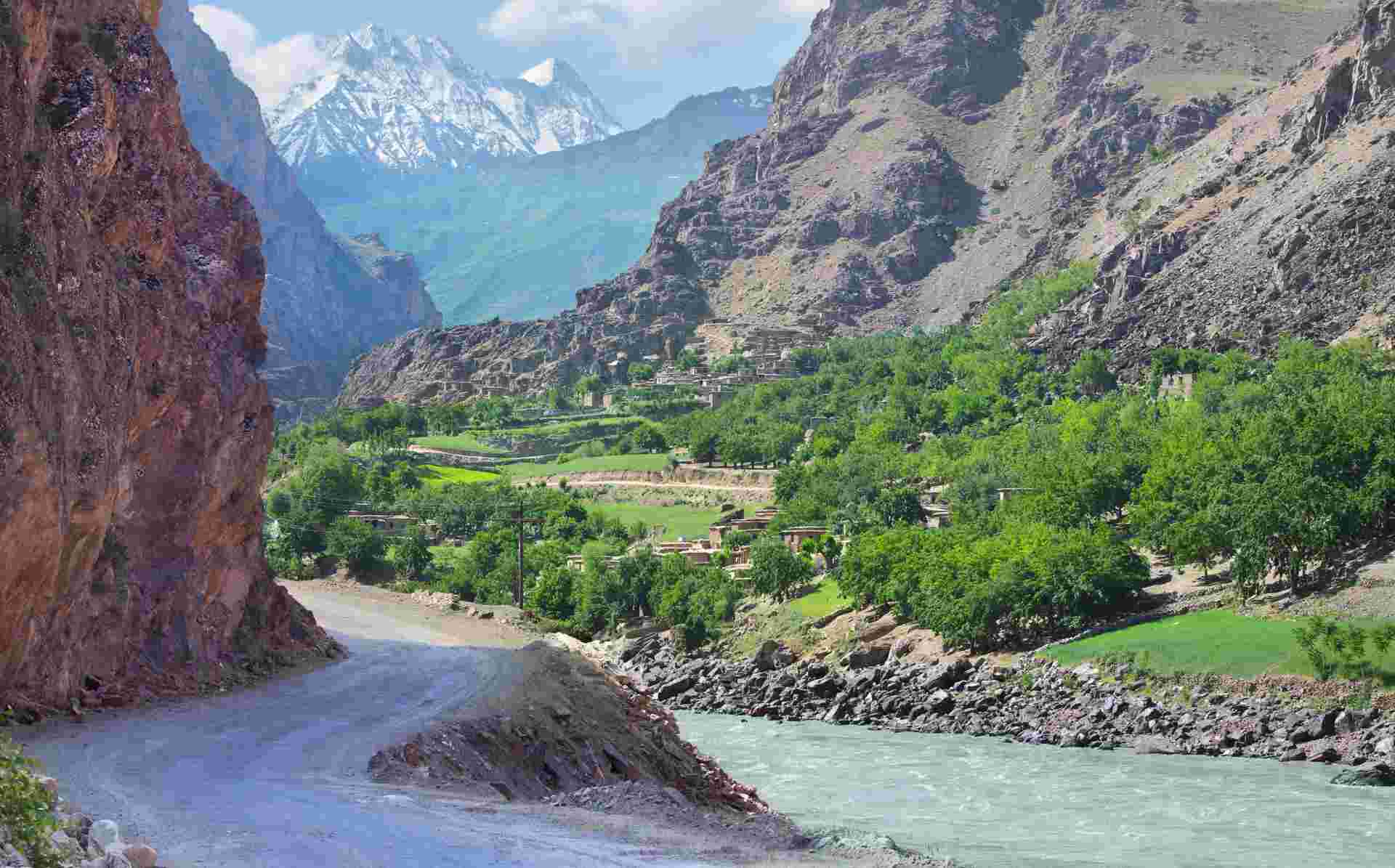
Get Trip Brochure & Exclusive Discount
Download a detailed PDF brochure and unlock an exclusive discount for this tour
What's Included
What's Excluded
Customer Reviews
Read what other travelers have to say about Tajikistan Expedition: Pamir Highway & beyond
Just do it
This was a trip, full of WOW moments with a good dose of awe and wonder. If you don't travel well in the back of a hot, very bumpy car for hours on end, this is definitely not the trip for you. If you can't do without home comforts, or don't like early mornings or sleep disturbances, this is not the trip for you. If you need your own space, this is not the trip for you. If you are in any way, a picky eater, this is not the trip for you.(having said that, our vegetarian and vegan group members ate as well as any of us) If, however, you have an open mind, and a 'come what may' attitude, this is a trip of a lifetime. The itinerary of this trip is such that we saw more of this amazing country and immersed ourselves in the culture of these amazing, resilient people more than any other trips that we encountered along the way. Some of the journeys were tough, with real abject dangers from their remoteness and altitude but the rewards in terms of scenery and experiences were more than worth it. The homestay hosts were, on the whole, welcoming and generous and they managed to provide well cooked food and little treats, even though they appeared to have so little. We engaged with the local children where possible, and took great joy in teaching them UNO and playing with them. They were inquisitive and always open to any new experiences we could provide. Rubik's cube was a hit too, as were the kites provided by Safina, our group leader. Because of the extent of the itinerary, we gradually learned so much about this relatively unknown country, both about the richness of its physical geography and the historical, cultural and social, regional traditions and differences. It had its tough moments but they only added to the lasting impression of an amazingly beautiful country of strong, proud and content people who thrive against the odds.
Tajikistan adventure
This was an excellent trip through the high Pamir region of Tajikistan. Expect fabulous scenery, warm hospitality from the local people, and a certain amount of roughing it. If you are not prepared for dormitory accommodation sharing one long drop toilet with up to 20 people this is not the trip for you. Much of the journey is at high altitude over 4000 metres with little time to acclimatise.
An Adventure Above and Beyond. Kris and Garth.
If you want a truly off the beaten track adventure then this is the one for you. Magnificent scenery, friendly hosts, culture and flora and fauna.
Adventure in the Pamir
This was truly an adventurous trip, in fact an intrepid 4x4 adventure into one of the least travelled parts of the world. The constantly changing scenery, geography and geology was often mind-blowing due to its vastness and beauty, especially with the spring flowers in bloom. Photographs do not do any justice. There are also stunning views looking into Afghanistan, Pakistan and China. The trip gave a brief insight into the culture and lives of the people. This was a well designed trip exploring as much of the Pamirs as possible in the short time period!!
A fabulous journey through the Wackhan valley to the remote and untouched Pamir mountains
This was the first trip Exodus have done to this area.. There is spectacular and varied scenery on route, wonderful people and definitely a journey to remember. I loved every minute of it. If you like an adventure, travelling to relatively unexplored areas, enjoy Mountains, like an insight into the lives and culture of the local people and their history and don’t mind roughing it a bit, this is a trip for you.
Tour Availability
Select your preferred departure date and secure your spot
Loading availability...
Monthly Price Comparison
Good to Know
Do you need help from our trip consultants?
If you have any question about this tour or need help with planning a trip, please do not hesitate to get in touch with us.
Our travel experts are ready to help.


Why Book with Bookmundi
Earn USD 229+ in travel credits.
Best price guaranteed.
No credit card or booking fees.
100% financial protection.
Carbon neutral tours.
25,000+ trip reviews, with an average rating of 4.8 out of 5.
